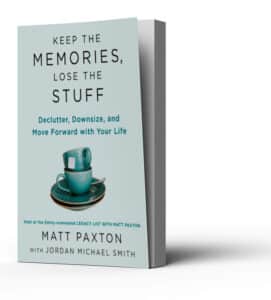
Maggie and her husband, Jesse, both in their midtwenties, had been living in a small apartment in Richmond when Jesse’s parents died suddenly in a car crash. Now Jesse was traumatized by losing his parents, and on top of that, he and Maggie were overwhelmed by the logistics of inheriting his family home, passed down from his grandparents to his par- ents and now to him, packed with generations of stuff.
About six months before she called me, Maggie, a schoolteacher, and Jesse, a U.S. Army veteran who had just finished law school, had moved from their small apartment in the city into his parents’ two-thousand-square-foot house in an up-and-coming suburb. It was the perfect starter home for them: two bedrooms, good schools nearby, a perfect green lawn, and the all-important white picket fence. It was a dream home.
Well, it should have been a dream home. But three generations’ worth of stuff was all crammed under one roof. I was into my fifth year of decluttering by then, but even I wasn’t prepared for the state of the house.
I literally couldn’t see the dining room table because it was covered with dishes; CDs; vintage vinyl records; clothing; boxes; magazines; mail (a mix of important documents, junk mail, and sympathy and Christmas cards); and God knows what else. The rest of the home was similarly chaotic, bursting at the seams with furniture, dishes, clothes, even car parts. There was barely enough room to move around.
This would have been a formidable challenge for anyone. But just after they moved in, Maggie and Jesse learned that Maggie was pregnant. On top of the grief, they had to make space for their new life with their soon-to-be bundle of joy. The precious time in their lives was still very much a painful one. By the time they brought me in, Maggie felt desperate and Jesse felt depressed. They couldn’t get started.
Jesse and Maggie weren’t alone in feeling stuck. Many people I work with don’t know how or where to begin decluttering, because they feel overpowered and overmatched by the immense jumble that is their living space.
The ten-minute sweep
We needed to dig in. I went with my secret weapon, the “Ten-Minute Sweep.” You clean for ten minutes every night, five nights a week. Take the weekends off, if you need to — and if you’re going through tough emotions at the same time, you definitely need that time off. Emotionally, you can’t expect to part in hours or days with objects you’ve had for years or even decades. That’s especially true when you’re going through upheaval in your life.
You can’t clean in one weekend a house that’s been lived in for thirty years. That’s not realistic — but you can clean for ten minutes. That’s realistic.
I suggested that Maggie and Jesse do their work in bite-size ten-minute blocks, the same time every day. I remember seeing a look of relief come over Jesse’s face when I suggested that. “Ten minutes!” he said. “That I can handle.” (Though honestly, when I’m working directly with clients, we usually go far over that limit once we get working. This is yet another reason why giving yourself time is essential to effective downsizing and decluttering: It puts less stress on you by offering you more breathing room.
Once I outlined the Ten-Minute Sweep, I could see the tension leave Jesse’s face, along with much of the guilt he’d felt over his difficulties decluttering for the past months.
I took this moment to talk to them about what I call “Pompeii hoards.” Like the ritzy ancient Roman city of Pompeii, which was covered by volcanic ash, Pompeii hoards are normal, clean homes that have been smothered by multiple generations’ worth of stuff.
First, there was his parents’ stuff, accumulated in the home they’d lived in for three decades. His parents, it turned out, had also kept many possessions they inherited from their parents. There was enough furniture for three homes jammed together in one small house.
On top of that were the belongings Jesse and Maggie had brought with them from their apartment. The city of Pompeii was destroyed by the ash, and I’ve seen homes destroyed by Pompeii hoards, too. The Ten-Minute Sweep to the rescue!
The Ten-Minute Sweep comes with a single catch, however: It only works if you stick to it. If you’re not careful, ten minutes per day can easily become five minutes per day, which soon becomes zero minutes per day, or fifty minutes one day a week. You can’t let happen. Nope. I’ve seen this happen time and again. The Ten-Minute Sweep works not only because it’s an easy lift, but because you get in the habit of decluttering. You need to commit to those ten minutes until it becomes part of your daily routine.
Once we did our first Ten-Minute Sweep, we headed to a nearby pub for a few beers, a part of the process I highly recommend! Jesse explained to me that while we were doing our work together, he was faced with reminders of what he’d just lost: photographs of his grandparents when they emigrated from Italy to the United States. His father’s records and saxophone. His mother’s board games and prize-winning paintings.
There were treasured artifacts from Jesse’s childhood: macaroni art from kindergarten, birthday cards, favorite toys, and athletic trophies. There was gear from his tours in Iraq. It was a delicate time to sift through all that, plucking items to keep and discarding others.
Additional Reading: Fear of Not Making Memories Keeps Seniors in Place
Jesse and I talked about our loss and pain, about how grief could be so enveloping that going through it made carrying out basic tasks difficult, let alone sifting through the intimate possessions of a loved one who’d just died. Like me, Jesse didn’t really have any choice about decluttering — I wish everyone could cull through their family’s objects while all our family members are still with us. But not everyone has that luxury. Sometimes you just need to make it happen.
One of the first things I like to say to new clients is: Understand your why. What are the reasons you want to get the clutter out of your life? Are you looking to have less stress in your life? Or do you just need more space for your stuff? If you’re moving, are you hoping to pare down your belongings, or do you want to take everything with you? Or are you making room for a friend to come live in the house?
Be as specific as possible in your objectives because your goals are what you’ll return to again and again for focus and motivation whenever you get stuck. You can’t win a race when you don’t know where the finish line is. And you’ll probably wind up running a lot more than you need to. Maybe pull a muscle, too.
Maggie and Jesse were clear on their main goal: Make enough space for their growing family. “There’s just too much stuff here,” Maggie said to me. Jesse reluctantly agreed, though that admission meant he’d eventually have to make some tough choices. But what did too much stuff mean exactly? I encouraged them to nail down the specifics.
I asked them question after question, and we all listened to their responses so together we could solve the problem. Did they want only their own stuff in the house? Or were they thinking of hanging on to some of what they inherited? Would just cleaning out the den for a playroom be enough, or did they want more space in the bedrooms and kitchen? What about clearing space to renovate the kitchen?
Sure, life is unpredictable and full of surprises. But while it’s impossible to anticipate all the hiccups and challenges that come our way, we tried to envision what they wanted in the future and how to create a home that could accommodate their dreams.
Choose a space that sets you up for success
Don’t feel that you need to tackle the hardest parts in your home first. In fact, I recommend doing just the opposite. Confronting that cluttered attic or garage can feel overwhelming and discouraging because seeing progress can be difficult. Nothing is worse than looking at a gigantic mountain you’re going to climb and feeling like you’ll never get to the peak. You feel so deflated at the impossibility of getting there that you give up and instead go for pancakes at the nearby diner. So remember this: You are taking one step at a time. The rest of the mountain will be there and you don’t need to stare at it or worry about how you’ll climb it.
“He looked around and saw a museum celebrating his parents and grandparents. He told me that he still felt guilty, that he still felt he was betraying his family by getting rid of some of their stuff.”
Once the dining room table seemed to magically reappear after its clutter was removed, Maggie was full steam ahead. She was heartened by our progress, small as it was. But Jesse remained heavyhearted. He looked around and saw a museum celebrating his parents and grandparents. He told me that he still felt guilty, that he still felt he was betraying his family by getting rid of some of their stuff.
I’ve found that guilt to be very common. We think we’re expected to carry on not just traditions passed down to us from our families, friends, and communities, but their actual belongings. But the reality is that you aren’t obligated to anything or lifestyle other than the one you want. That’s what this is about: building the life you want, not the life you think you should have or that you think a loved one would want you to have.
To make this happen, you need to be kind to yourself by allowing yourself to let go of expectations about your obligations to inanimate objects. Nobody else can give you that gift — it’s something that you have to do for you. But whether it’s items you inherited, as in Jesse’s case, or items you’ve kept for twenty years, stop beating yourself up about moving on without them.
Don’t feel guilty for giving something away that your great-aunt gave you when you were eighteen. You are sixty-five, and she’s been dead for thirty years — she is probably okay with it. But fair warning: Giving yourself a permission slip to let go of things also means letting yourself feel deep, powerful emotions. I tell all my clients, “This is real to you, so whatever emotion you have, it’s valid and real. Embrace it.”
The physical process of decluttering and downsizing is a lot of work, but the hardest battle is fighting through the emotional and psychological barriers. As Jesse stared at his father’s baseball bat in his hands, I asked what he thought his parents would want for him. He looked at me and said softly that he knew they would want him to be happy, to make this into his home, to start a new life with his growing family there. That, not oversight of a museum for their belongings, was what they wanted for him.
Loving who you actually are
Sometimes guilt about our loved ones’ belongings isn’t what’s inhibiting us from downsizing or decluttering. Instead, we’re reluctant to give up on our visions about ourselves. This includes the fancy home-gym equipment that’s never been used, that sporting equipment from a time long ago, and the clothes that you will never fit into again. (For years I deluded myself by holding on to one pair of size 30 jeans from my twenties. I will not confirm if they are stonewashed.)
We have to force ourselves to say goodbye to our “fantasy self” items, the stuff that we think we’ll use when we’re different versions of ourselves. Sometimes we imagine ourselves to be different people, instead of admitting who we actually are. It’s not depressing to concede that you won’t ever get around to playing racquetball again after twenty years, or that you’ll never finish that painting you started during the 1980s. (Yes, these are actually things my clients have gotten rid of.)
Instead, it’s loving to say to yourself that you’re a wonderful, unique person just as you are, right now. When you find an item in the attic that you bought hoping one day you’d use it, remember that it was a stepping-stone to the person you are today. When you got it, you needed it. Even if you never used it once. Now you are ready to move on, because you’ve grown. Maturity is realizing we’re all human and that wisdom comes from self-acceptance.
The ‘Maybe Pile’
To ease into things, I suggested to Jesse that we create a section of the house where we could put inherited items that we might get rid of. I called it the Maybe Pile — another secret weapon of mine. A Maybe Pile basically offers people some breathing room when the going gets a little too tough for them to make snap decisions about items. It’s not kicking the can down the road: It’s actually a subtle way to introduce into your head the idea of being separated from these items.
Once an item goes into the Maybe Pile, it’s easier to imagine yourself getting rid of it. And really, 75 percent of the stuff in Jesse and Maggie’s place went into the Maybe Pile. It was easy for him to tell himself that he wasn’t getting rid of the rolltop desk, the record player, the dishes, the dresser, or the clothes — he was just considering it by putting them into the Maybe Pile.
Three weeks later, when the time came to empty the Maybe Pile, he found it much easier than he would have otherwise. With time, the idea of getting rid of those Maybe items had worked its way through Jesse’s mind. In the end, only a handful of Maybes went into the Keep Pile. Time is the key ingredient of the Maybe Pile.
The only things that remained in the Maybe Pile were things that Jesse put on his Legacy List.
Legacy List
A Legacy List isn’t just the catchy title of my hit show on PBS. A Legacy List is also a tally of five or six must-have keepsakes, items that have so much inherent worth that it just makes sense to hold on to them. They are the material possessions that you value the most. You will tell their stories for years to come. Preserving them for generations past and present can be a wonderful way of keeping your ancestors and loved ones alive. For all the importance of decluttering and downsizing, it’s crucial to set aside a few select things that you are going to keep.
For one thing, preserving the past, savoring the special moments and people from your life, is a deeply human activity. You’re trying to simplify and improve your life by paring down your possessions, not attempting to remove all traces of your past like Don Draper from Mad Men. Also, by allowing yourself to indulge in half a dozen essential artifacts, you’ll have an easier time getting rid of the less important stuff. Telling myself I’ll never eat mint chocolate chip ice cream again is not realistic; I can better stick to a diet where I have ice cream once a week (maybe twice).
For Jesse, the must-haves were these: one of his dad’s old suits, his grandmother’s crossword puzzle books, an end table, a china cabinet, and a hardback chair. As you can probably guess by now, I made sure to ask him why he wanted those items on his Legacy List: I wanted to hear his stories of these most valued objects. Truth be told, it would be hard for most people to understand preserving crossword puzzles that have already been solved. But all that mattered was that they were important to him. Sentimental value, like beauty, is in the eye of the beholder.
Taking time to celebrate
Once you make some progress in your clutter, take a breather, kick up your feet, and enjoy the moment. You’ve worked hard to get here. After Jesse, Maggie, and I got through the table or finished a drawer or room, we cheered our success. Celebrate your accomplishments, no matter how small. I was constantly impressed by Jesse’s bravery and emotional intelligence in going through his family’s possessions, and I told him so.
I’ve learned one truth over the years, both at home and at work: Praise inspires us, so pile on the verbal trophies, no matter how big or small the accomplishment! Don’t underestimate this tip. Praise will keep the ball rolling and set the tone for success.
 This article is an excerpt from the book “Keep the Memories, Lose the Stuff” by Matt Paxton, a downsizing and cleaning expert, speaker, author, radio personality, and host of the two-time Emmy nominated television show “Legacy List with Matt Paxton.”
This article is an excerpt from the book “Keep the Memories, Lose the Stuff” by Matt Paxton, a downsizing and cleaning expert, speaker, author, radio personality, and host of the two-time Emmy nominated television show “Legacy List with Matt Paxton.”







